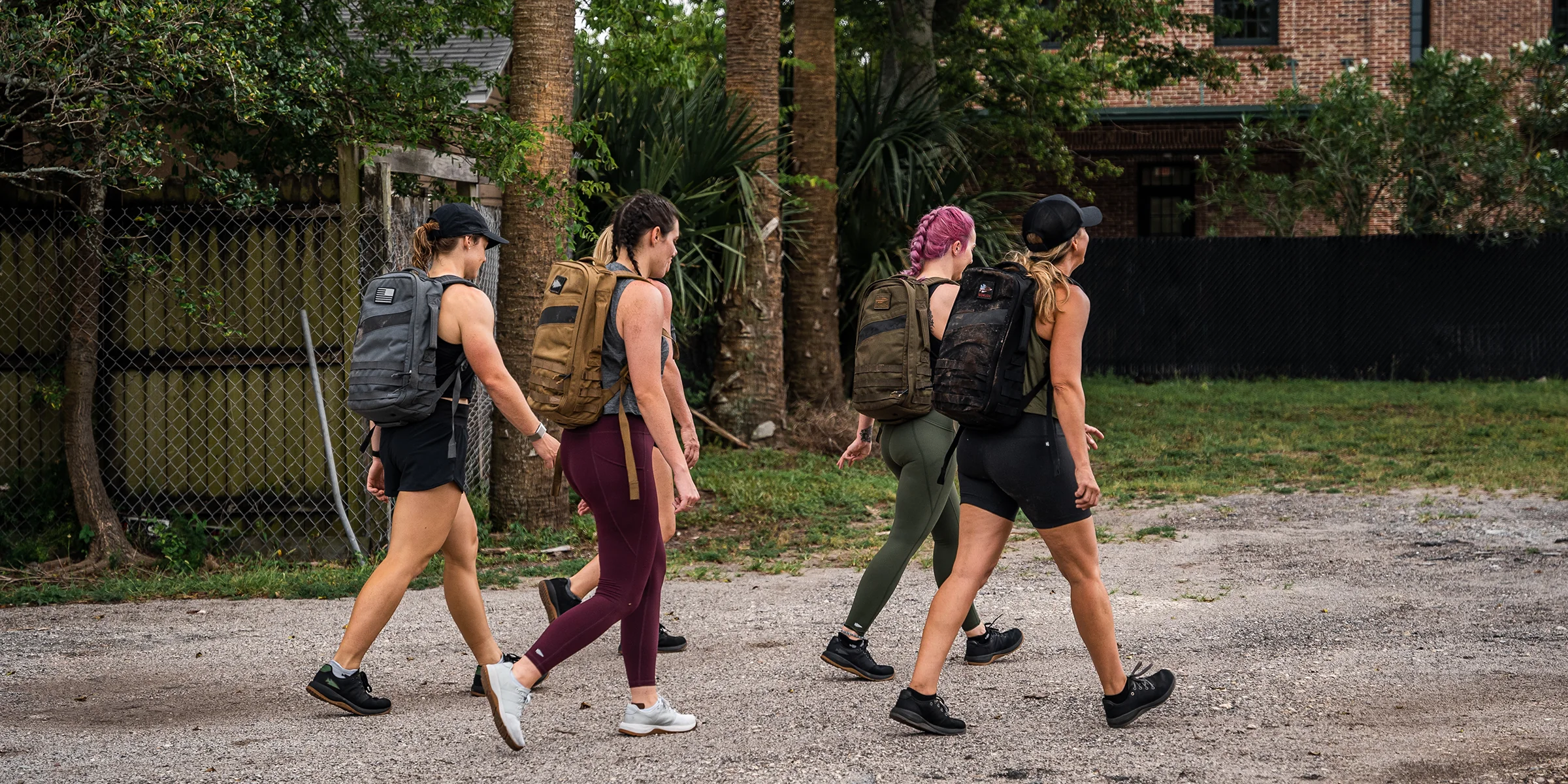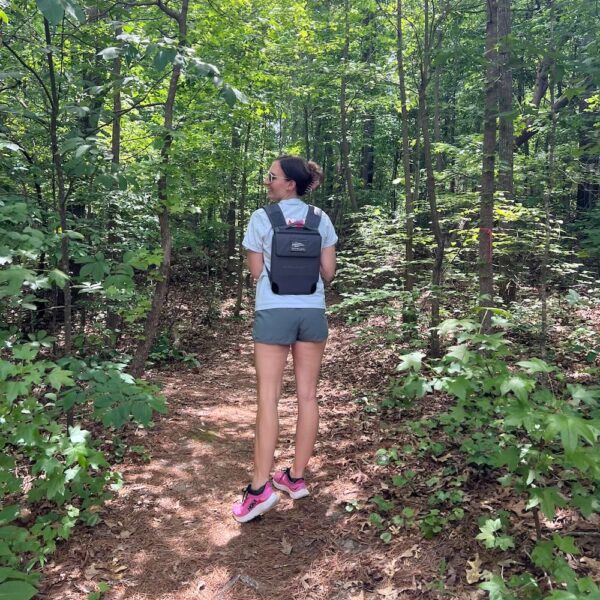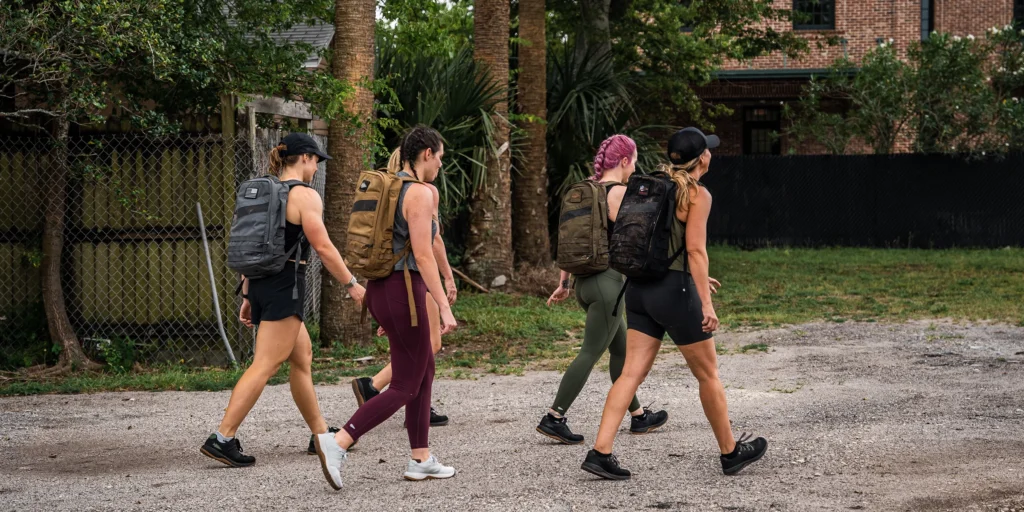Introducton

The right rucking for beginners equipment and accessories are critically fundamental in achieving the desired results when rucking. The feet and back protective gear is vital as it helps defend against injuries while improving performance. In addition to protective gear, practical suggestions along with structured training regimens greatly improve stamina, strength, and overall fitness. This guide is meant to prepare you so that once you rucking, you will be able to challenge yourself confidently.
Key Takeaways:
Haven’t emphasized proper clothing. Suitable attire for the weather, fitting bags, and good shoes are very important.
Initially, low distances and light weights should be used. Both can be increased over time to build endurance.
These Injury prevention policies need to be complemented with skill-enhancing training plans focused on work-rest performance cycles, hydration, consistent work, and strength training, to prevent injuries.
What is Rucking? A definition
To define simply for beginners in fitness, rucking is basically walking for fitness; it is a more advanced version of walking as it involves a weighted rucksack.
The primary goal here is not only rucking but also enhancing stamina and strength through added weight. Rucking optimally fuses aerobic and anaerobic exercises into one single workout, doable by almost anyone. This form of muscle-enhancing rucking maximizes efficiency and cadence, thereby making it effortless to integrate into a routine.
History and Origin

Rucking is considered one of the oldest forms of fitness as it derives from military training. It aimed to address the physical demands of soldiers who had to carry heavy equipment, developing later into a practical form of conditioning. It was not only rucking’s initial purpose but the physical training gained tremendous focus beyond the military. Rucking became popular among fitness enthusiasts who’s keen on augmented versatility in robust strength and endurance exercise.
Approaches to rucking go centuries back when armies compelled their soldiers to march with heavy packs as a form of training. Friendly motivation makes rucking effortless as there’s always someone readily available to push you towards your limits. The term “rucksack” is derived from German meaning “back sack”, displaying its military origins. Rucking not only prepares someone for the challenge but trains the mind to withstand extremely tough mentally endurance demanding situations.
Benefits of Rucking for Beginners
Since the exercise involves walking while bearing weight, rucking has several advantages physically and mentally. It improves endurance, cardiovascular health, and muscular strength. Moreover, rucking can be performed by any fitness level and is less prone to injuries compared to running. Thus, rucking is an useful approach to enhance one’s fitness.
In addition, rucking can be done outdoors with other people which helps in social interaction. These two forms of aerobic exercise also aids in weight loss. This form of exercise not only strengthens the body, but can also fortify the mind through enhanced self-discipline, will power, and greater mental resilience. Given all these benefits, rucking is beneficial for all types of fitness enthusiasts.
Common Myths Rucking for Beginners

Due to a lack of understanding, rucking for beginners and their many variants are considered to be walks done with a heavy load on one’s back. The reality is, rucking is much more involved than just walking or running. As with any activity, rucking demands pacing, proper technique, appropriate altitude, and fluid mechanics to ensure it is metabolically helpful and not injurious. Understanding the importance assists one in mastering the skill of rucking.
The belief that it introduces too much challenge for a beginner rests on false logic. Every new thing begins with the right groundwork and incremental scaling of demands. These misconceptions are what enable people to access the more adaptive variety of training, armed with the right guidance.
Required Accessories For Rucking for Beginners
Choosing Your Rucking Backpack
The pack should be comfortable without compromising on balance, ruggedness, and ease of carrying weight. A rucking pack designed, tailored specifically for these criteria, will not only enhance your experience rucking on a singular occasion, but on the entire rucking journey.
Consider a pack featuring padded shoulder straps, a waist belt, and a ventilated back panel that helps alleviate back strain while improving the distribution of the load’s weight. For novices, the most suitable size is generally in the 20-40 liter range.
Selecting Appropriate Weights.
Your sessions will be safe and effective with the right backpack and weighted load, so think carefully about each. Refrain from overly ambitious starting weights on the lower end of 10-20 percent of your body weight during warmup. Endurance on pace is key. Trying too much too fast, as most, leads to injury or fatigue, so the best course is to incrementally increase support as strength is gained.
Another factor is the objective of the rucking session and the terrain you intend to take on. When ‘rucking’ the city, lighter loads will boost speed and distance; on the trail, heavier packs will add to the resistance. Always pay close attention to your body during and after the ruck to decide whether changes for comfort are necessary versus going overboard.
Boots or Shoes Rucking for Beginners
In addition to your pack’s weight, which always matters, what footwear you choose is equally important. To novices, lightweight hiking shoes with decent treads are often the most suitable. However, rougher terrains need boots because of the added support and protection around the ankle. More specifically, the decision between shoes and boots fundamentally relies on the weather condition and effort grade for rucking.
For example, shoes would be more suitable for lighter rucking and well-maintained paths, while boots would excel in steep, rugged off-trail terrain. No matter what, proper fit and comfort will help achieve tailored objectives.
Clothing Recommendations Rucking for Beginners
Alongside the shoes, the Smart design on the upper portions of the outfit should allow unrestricted movement and permit moisture wicking. Combating overheating needs cool, lightweight, breathable , and quick drying materials to prevent chafing. Another one of the many smarter strategies is layering to account for shifts in weather during the ruck.
Using these methods will help keep temperature within limits while avoiding overheating or moisture, which can be distracting during training. Moisture-wicking socks and a moisture managing base layer also enhance the experience by shifting focus toward training instead of discomfort.
Additional Gear and Accessories Rucking for Beginners
In addition, these items may enhance safety and comfort while on the trail. These include a hydration pack or water bottle, small first aid kit, and headlamp. Depending on the route, a GPS tracker or smartphone holder could be essential for effortless navigation.
Due to the varying weather and climatic features, it is best to always carry some sunscreen, insect repellent, and energy snacks. This way one’s protection and nourishments all in one keeps improving leash prolonged sessions.
Preparing for Your First Ruck
Assessing Your Current Fitness Level

Making plans for a Rucking for Beginners
A good rucking plan tells you what to do to keep going. This tells you how far to walk, how much weight to carry, and how often to ruck. If you start with two to three workouts a week, it will be easier to get used to and recover faster. Moving your body forward also saves you from getting hurt and working out too much. Scaling more not only makes you better, but it also stops you from working out too much.
When you have a clear plan that keeps you accountable, it’s simpler to recognize how far you’ve come. You should rest so your body can repair, and then gradually increase the weight and distance of your lifts. Rucking is a sort of cross-training that helps you gain muscle and stretch at the same time. It helps you get in better shape and do better at rucking. When people do things like this, they are more likely to stick to their plans and feel better about themselves.
How to keep safe for folks who are new to it
When teaching someone how to ruck safely, the first three things you should do are:
Take care of the paths that have been rucked up.
Keep your distance such that it gets bigger as the ruck gets heavy and time goes on. ©x
To be safe when hiking, drink enough water and carry a backpack that fits well.
If you see signals like working harder than normal, the activity should be more fun, and you should feel safe that you probably won’t be hurt.
A Four-Week Plan for People Rucking for Beginners
If you’re new to working out and want to get healthy, you should start with shorter distances and lesser weights to improve your strength and endurance. Over the course of the month, you should gradually add greater weight and distance to your rucks. This will assist your body get used to it without injuring itself.
You will ruck for three days and then take a day off to help you grow better over time.
Rucking plans for people who are at an intermediate or advanced level
The planned routine that is emphasized in intermediate and advanced training plans is supposed to make things more fun and challenging. To get stronger, fitter, and mentally stronger, these regimens imply you need to work out more, with longer distances and heavier weights.
| Elements | Description |
| Distance | Up to 12-15 miles per session |
| Load | 20-50 lbs, depending on your goals |
| Frequency | 4-5 sessions per week |
| Speed | Incorporating intervals or steady pace rucking
|
Consequently, progressive overload is necessary; increasing load, distance, or frequency gradually avoids plateauing and injury.
| Training Focus | Strategy |
| Load Progression | Add 5 lbs every 1-2 weeks |
| Distance Increment | Increase miles by 1 every week |
| Active Recovery | Incorporate low-intensity walks |
Adding strength training
Strength training can help you carry more weight in your ruck and keep the muscles you use when rucking strong. Work on your legs, core, and back to make rucking easier and less likely to hurt yourself.
When you’re rucking, it’s far better to do strength training exercises like squats, deadlifts, lunges, and planks. If you do these workouts a lot, your muscles will undoubtedly last longer. This will help you stay strong and keep your ideal posture as you ruck for a longer time.
How to cross-train
Cross-training with rucking is more fun, helps you get fit faster, and lowers your risk of getting hurt. After rucking, swimming and bicycling are two additional wonderful methods to grow better, get more flexible, and keep your heart healthy.
Cross-training not only makes working out more fun, but it also gives your body a break, balances the muscle groups used during rucking with less concentrated effort, and pushes you to set new and diversified rucking goals.
When you ruck, keep your back straight and use good form.
When you ruck, your back should be straight, your shoulders should be relaxed, and the weight in your pack should be evenly spread out. If you bend too far forward or backward, your lower back may hurt worse. Active bracing will keep your spine healthy and help you stay alert. As always, carrying something with better form makes you work faster and hurt yourself less.
10 Best Core Exercises for Beginners at Home: Build a Stronger Core Without Equipment
Ways to set a pace and build endurance
Rucking, like any other type of exercise, should be done at the proper speed. To get better at rucking, you need to go at a steady pace to build up your stamina. Be sure to run at a steady, acceptable pace. If you go too fast at beginning, you can get exhausted quickly. You can utilize sprints whenever you want. Your body will get adapted to it better over time if you switch between fast walking and slow recovery steps. Make sure your mileage goals are realistic and can be raised with time. This will help you build your endurance without placing too much strain on your body.
Taking breaks at the correct moments during your rucks might help you stay awake. Drink water, check your gear, and make sure you’re comfortable the whole time throughout pauses. You can use apps or a notebook to keep track of how much faster you’re becoming, and you can take breaks at particular periods. Change the pushed effort during the times when it is let go.
How to Breathe
When you ruck, controlling your breathing helps you get more oxygen, feel less weary, and save energy. Take deep, regular breaths by breathing in through your nose and out through your mouth. This plan is good for keeping your heart rate stable and your endurance up, especially when you have to carry big things or climb steep hills.
This plan also helps you stay focused and relaxed, keeps you from becoming tired too quickly, and makes the whole rucking experience better. Breath-step coordination, or taking three steps for each breath in and three steps for each breath out, might make it much simpler to keep going.
Things to keep in mind when you’re on the path and when you’re navigating
You need to be able to read the trail and know what the conditions are like behind you to be good at rucking. The distance, your degree of fitness, the weather, and the difficulty of the terrain all make sure that the trip is safe and entertaining. Maps, GPS gadgets, and trail apps are all examples of navigation tools that can help you stay out of trouble.
So, if you pay attention to changes in the environment, such rocky sections, steep hills, or muddy paths, you can modify your pace and foot placement so you can ruck at a steady pace without getting wounded. This makes rucking safe and enjoyable.
Rucking in Different Areas
Rucking in the City: Streets and Parks
Running around the suburbs and parks is a fun and free way to get some exercise. The smooth surface makes it simple to sustain a steady pace, and the rest and water stations make it even better. But it is important to keep an eye on foot traffic. On the other hand, city parks use plants and other natural objects to make the view more beautiful.
Trail Rucking: The Weather and the Terrain
Trail rucking is less predictable than the streets since it has natural impediments, different types of terrain, and other challenges that help you work on your balance and endurance. You need to pay attention and modify your footwork because of roots, rocks, and uneven ground. In the future, you will be stronger and more flexible, which will make rucks more fun and gratifying.
Not to mention the extra height changes, which made the workout a lot harder with steep hills and dips. It’s crucial to get the correct shoes and plan the trip so you don’t get wounded. Getting ready properly also makes the event safer and more fun.
6 12 25 Workouts: The Muscle-Building Secret Behind This Brutal Hypertrophy Method
Things to consider about when it comes to the weather
Like with any other workout, you should schedule your rucking carefully based on the conditions. There needs to be a plan for each ruck that may be adjusted as it goes along. You could require clothes that can handle water if it’s snowing or raining, for example.
You should keep in mind that these kinds of weather make rucking harder and more dangerous. When it rains, the routes might become slippery, which makes rucking less safe. When it’s hot outside, drinking enough water can make you feel better. . It also helps you do your best and feel good.
Rucking with other people or by yourself
Headspace is a terrific place to go by yourself since it teaches you to rely on yourself. It’s nice to cheer yourself on when you’re doing things by yourself, but bears are better off when they ruck with other bears because it makes them feel protected and gives them social drive. It all depends on what you want to do and what works best for you.
Rucking as a group definitely makes it more enjoyable and keeps everyone accountable. When you ruck alone, though, all you can focus about is your body and what it’s doing. This makes it a nice area to meditate outside. You can use both strategies to aid you with your travel and your training.
Conclusiom
This handbook for beginners on Rucking for Beginners gives you the workouts, safety tips, and regular schedules you need to get started. You will get stronger and survive longer over time if you pay attention to your body and use the right form. Remember that this isn’t a race. You and your body will get the outcomes you seek if you wait. So enjoy yourself while you can! Do the work and have fun rucking.
FAQ
Q: What do I need to know before I start rucking?
A: To start rucking, you need a sturdy backpack with a good frame, a weighted rucksack or weight plates, shoes that are comfortable and support your feet, socks that keep your feet dry, and clothes that are suited for the weather. You should also bring a water bottle or hydration pack so you don’t get dehydrated while you ruck.
Q: When someone first starts rucking, how much weight should they carry?
A: Beginners should start with a smaller load so their bodies can become used to it over time. Many people say that you should start with 10% of your body weight, which is about 15 to 20 pounds. You might be able to add more weight over time as your strength and endurance grow over the course of many weeks.
Q: How often should I go rucking when I start a new training program?
A: If you’re just starting out with rucking, doing it two to three times a week is a wonderful way to get started. This offers your joints and muscles a break between workouts, which helps them get stronger and last longer. Take a break if you’re fatigued or in discomfort.
Q: What can I do to keep safe while Rucking for Beginners?
A: To avoid getting wounded during rucking, maintain your shoulders relaxed and your back straight. Wear shoes that fit well and give your feet support. Gradually increase the weight and speed of your workouts. Make sure you stretch both before and after. Taking breaks and drinking water during long rucks might also help you feel less stressed.
Q: How do you choose the best backpack for Rucking for Beginners?
A: Choose a backpack that can contain a lot of stuff. It should feature padded straps on the shoulders, a waist belt to evenly distribute the weight, and a frame or structure that keeps the load steady. The bag should be big enough to store your weight plates and other things, and it should fit snugly so that it doesn’t shift about as you work out.
Related Content
- Active Living
- 15 Pilates Exercises for Beginners: A Gentle Start to Core Strength and Flexibility
- HIIT Workouts for Beginners: How to Start and See Results Fast
- The 3 Best Beginners Weight Training Tips
- Healthy Eating Meal Plan for Wellness
- 4 Best Exercises for Health

